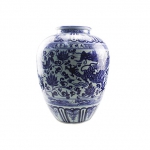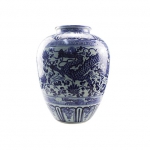四川永合利精品推荐丨大明宣德年制款青花缠枝花卉龙纹大罐
四川永合利拍卖有限公司,为藏品强大的传播效应向各位买家推荐经国家一级鉴定专家甄选的艺术珍品 , 为藏家牵线搭桥 , 让千百件艺术珍品价值被发掘与重视 , 在拍卖会上得以高价成交。
Sichuan Yonghe Li Auction Co., Ltd. For the strong dissemination effect of collections, we recommend to buyers the art treasures selected by experts of national first-level appraisal, and make a bridge for Tibetans, so that the value of thousands of art treasures can be excavated and valued, and high-priced transactions can be concluded at auction .
【名称】大明宣德年制款青花缠枝花卉龙纹大罐
【规格】高:34cm 口径:9.6cm
【类别】瓷器
[Name]Dragon-pattern jar of blue and white twisted flowers made in Xuande year of Daming
[Specification] High: 34cm caliber: 9.6cm
[Category] Porcelain
今天给各位藏友带来这件藏品是 大明宣德年制款 青花缠枝花卉龙纹大罐,藏品来自于一位中国 四川的谢先生,该件藏品 高:34cm,口径:9.6cm,罐身龙云纹样的绘制所用青料皆有浓淡,墨势浑然而庄重。此御龙气势慑人,实为皇帝彰显权力之象征。许多鉴赏家视宣德御瓷的龙图为中国瓷器史上最优秀的代表,此器更是生动活现,绝妙非凡,这次希望通过平台给各位鉴赏。
Today, I bring you this collection of Dragon-pattern jars of blue and white twisted flowers made in Xuandenian of Daming Dynasty. The collection comes from Mr. Xie of Sichuan Province, China. The collection is high: 34cm, caliber: 9.6cm. The blue materials used for drawing dragon cloud patterns on the tank body are all shallow and the ink is vigorous but solemn. This powerful imperial dragon is a symbol of emperor's power. Many connoisseurs regard Xuande Imperial Porcelain's Dragon Picture as the best representative in the history of Chinese Porcelain, which is more vivid and wonderful. This time, I hope to give you an appreciation through the platform.
明清时期,青花瓷从鼎盛又走向了衰落。在明永乐、宣德时期是青花瓷器发展的一个高峰,当时是以制作精美著称,总的说来,这一时期的官窑器制作严谨、精致;民窑器则随意、洒脱,画面写意性强。从明晚期开始,青花绘画逐步吸收了一些中国画绘画技法的元素。而下图便是小编有幸见到的青花龙纹大罐。
In the Ming and Qing Dynasties, blue and white porcelain went from prosperity to decline. In the Yongle and Xuande dynasties of Ming Dynasty, the development of blue and white porcelain reached a peak. At that time, it was famous for its exquisite production. Generally speaking, the official kiln wares in this period were made precisely and exquisitely, while the folk kiln wares were free and easy, and the pictures were freehand. From the late Ming Dynasty, blue and white painting gradually absorbed some elements of Chinese painting techniques. The following picture shows the blue-and-white dragon-shaped jar Xiaobian was lucky to see.青花缠枝花卉龙纹罐,顾名思义,因罐身绘有飞云龙而得名,此罐微折口、短颈、溜肩、鼓腹、平底,除了罐身绘有飞云龙外,还绘有祥云与花卉缠枝,颈口绘有回纹饰,飞云龙下方绘有两条弦线。造型丰满、浑厚、古朴,器型线条柔和、圆润,给人以质朴、庄重之感。其胎体,琢器指立体造型,较厚重。
Blue and white twisted flower dragon pattern pot, as its name implies, is named for the painting of Feiyunlong on the body of the pot. The pot has slight folds, short neck, shoulder slippage, belly drum and flat bottom. Besides the painting of Feiyunlong on the body of the pot, it also draws auspicious clouds and flowers twisted branches, with a back pattern on the neck and two strings under the painting of Feiyunlong. The shape is plump, thick and simple, the lines of the utensils are soft and round, giving people a sense of simplicity and solemnity. Its carcass, Carver refers to three-dimensional shape, relatively thick.
明清是我国瓷罐史上的鼎盛时期,由于“罐”与“官”谐音,罐在人们心目中的地位超过了瓶、尊,成了兴旺门庭的吉祥物。它们的用途与品位,也就自然而然地得到提升,并取代瓶,成为达官显贵居家摆设的重要物品。
Ming and Qing Dynasties are the heyday in the history of China's porcelain pots. Because of the homonym between "pot" and "official", pots have surpassed bottles and honors in people's minds and become the mascot of a prosperous family. Their uses and tastes are naturally promoted, replacing bottles and becoming important items for dignitaries and dignitaries to decorate their homes.








